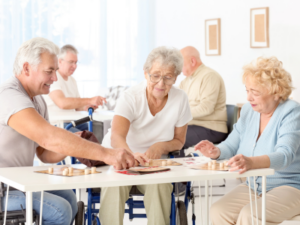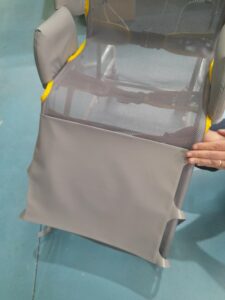We were honoured to support the DIY SOS team and work with many other trades to transform Rafi and his family’s lives.
 DIY SOS is a well-loved and popular show, with a strong commitment to bringing tradespeople and suppliers together to transform the lives of genuinely deserving individuals. The Prism Healthcare Group of companies is dedicated to helping people of all ages and abilities carry out everyday activities that most of us take for granted. We were very proud to be part of this touching initiative to change the life of such an inspiring person. The episode first aired on BBC One on Friday, 17th October at 8 pm and is available to watch on iPlayer.
DIY SOS is a well-loved and popular show, with a strong commitment to bringing tradespeople and suppliers together to transform the lives of genuinely deserving individuals. The Prism Healthcare Group of companies is dedicated to helping people of all ages and abilities carry out everyday activities that most of us take for granted. We were very proud to be part of this touching initiative to change the life of such an inspiring person. The episode first aired on BBC One on Friday, 17th October at 8 pm and is available to watch on iPlayer.
In September 2023, seven-year-old Rafi fell seriously ill and was rushed to hospital, where he was diagnosed with haemolytic uremic syndrome—a rare condition caused by E. coli toxins. The illness resulted in kidney failure and severe damage to his brain stem. Despite all odds, Rafi began to breathe independently. Gradually, his organs started to recover, and after months in hospital, he was finally able to return home. While the family was overjoyed to have Rafi back, their home was no longer suitable for his complex needs. Without significant adaptations, Rafi risked needing to return to hospital care.
Prism Medical UK donated a ceiling track system, comprising a Transactive Xtra 130 ceiling hoist, a double H-system and a Transition Gate to link the systems. This is the first time such a system has been completed on a DIY SOS build – a fantastic milestone for our team and a testament to our innovation and commitment to accessibility. Alongside Nick Knowles and a team of volunteers, our expert engineers helped transform this family home, allowing the family to continue living together.
Thank you to the DIY SOS team for trusting us with this project, and to all the other volunteers and contributors who collaborated on this life-changing effort. We would like to give a special thanks to the colleagues directly involved in the design and installation.
- Dave McNamara, Major Projects Specialist, who conducted the site survey and proposal.
- Stuart Patterson and Chris Long, who installed and tested the ceiling track system.
We feel privileged to have been asked to collaborate on this project, which aligns closely with our mission, “To transform the quality of life of people with health conditions by providing solutions that offer choice, value for money and help to make care easier.” Projects like DIY SOS highlight the importance of community, compassion, and collaboration. Together, we transform lives.
If you didn’t manage to catch the episode, it is now available to stream on iPlayer.















 As society ages, the demand for day-to-day living support continues to rise. However, social care faces challenges amidst this growing need, particularly with funding cuts that have led to staff shortages and reduced training opportunities. In navigating these troubled waters, ensuring the safety and well-being of carers and those they support becomes paramount. If you have concerns regarding the safe handling of a loved one, we encourage you to contact your local social services department and request an Occupational Therapy review of the moving and handling risk assessment and plan.
As society ages, the demand for day-to-day living support continues to rise. However, social care faces challenges amidst this growing need, particularly with funding cuts that have led to staff shortages and reduced training opportunities. In navigating these troubled waters, ensuring the safety and well-being of carers and those they support becomes paramount. If you have concerns regarding the safe handling of a loved one, we encourage you to contact your local social services department and request an Occupational Therapy review of the moving and handling risk assessment and plan. In healthcare environments, moving and lifting individuals is a common task that demands precision and care. Any ‘caregiver’ that needs to move or lift a person is at a high risk of lumbar complaints or disorders.1 When performed correctly, it enhances independence and quality of life while minimising the risk of injury.2 A 2013 study testing different patient transfer types showed that the lumbar load was considerably reduced when using optimised techniques or assistance aids.3 However, inadequate training and improper techniques can result in accidents and discomfort for carers and clients.
In healthcare environments, moving and lifting individuals is a common task that demands precision and care. Any ‘caregiver’ that needs to move or lift a person is at a high risk of lumbar complaints or disorders.1 When performed correctly, it enhances independence and quality of life while minimising the risk of injury.2 A 2013 study testing different patient transfer types showed that the lumbar load was considerably reduced when using optimised techniques or assistance aids.3 However, inadequate training and improper techniques can result in accidents and discomfort for carers and clients.
 Also known as the underarm lift, this is when the client is lifted or supported under the armpit. It is typically used to lift someone up the bed, support them from sitting to standing or help them from the floor. It is done by hooking the elbow around the client’s arm, just under the armpit, and dragging them to the desired position.
Also known as the underarm lift, this is when the client is lifted or supported under the armpit. It is typically used to lift someone up the bed, support them from sitting to standing or help them from the floor. It is done by hooking the elbow around the client’s arm, just under the armpit, and dragging them to the desired position.


